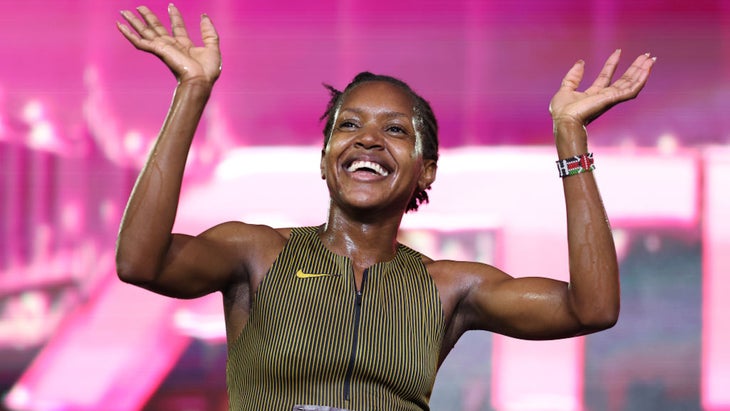After the cheering was done—after Faith Kipyegon took her best shot at a four-minute mile, after she’d crumbled to the track in exhaustion, picked herself up, jogged a celebratory lap, warmed down, showed up to a press conference where she and other members of the Breaking2 team fielded questions from journalists—after all that, as the sun set last Thursday evening at Stade Charléty, a half-dozen of the pacemakers were still circling the warm-up track, cranking out hard intervals. It was a reminder that, while Kipyegon’s race felt like the biggest deal in track for a few hours, the track season is just getting started. With that in mind, here are a few thoughts on what we learned in Paris and where we go from here.
The (Not Unlimited) Power of the Mind
Throughout the build-up to Kipyegon’s race, it’s been hard to avoid comparisons to Eliud Kipchoge’s Breaking2 marathon in 2017. As a science journalist who covered both events, what jumped out at me was the lack of concrete data—or at least publicly available data—underlying Kipyegon’s attempt. In 2017, Nike provided specific insights on how much more efficient its new shoe was (four percent) and how much they expected to gain from their pacemakers (equivalent to running downhill at a 2.5 percent grade).
For Kipyegon, in contrast, they mostly stuck to generalities. The day before the race, the company release a list of ten key details that went into planning the race—things like “Let Faith Be Faith” and “Instill Confidence” and “Pump Up the Color.” I’m a big believer in the mind’s role in determining the limits of endurance (I wrote a whole book about it)—but it seems to me that it works best when you’re building confidence in your abilities and preparation. There comes a point where, if your focus is instilling confidence in the power of being confident, it starts to feel a little circular.
It’s been hard to figure out how much of the difference between the two events is an unavoidable consequence of the harder-to-quantify physiology of the mile compared to the marathon, how much is a messaging decision by Nike to keep the focus on Kipyegon rather than on the scientists, and how much is a genuine difference in how they prepared. Given the scale of the event and the resources involved, you have to assume that they had good reasons to think the sub-four goal was plausible. It’s too bad they weren’t willing to share more of that thinking.
The Future of Exhibition Events
The most controversial thing about both Breaking2 and Breaking4 was the fact that they didn’t adhere to the rules necessary for official world records. I asked Lauren Goss, a track and field historian at the University of Oregon, whether these sorts of unofficial events have any precedent. “The rules and definitions of what constitutes official competition—and who gets to decide—are constantly evolving,” she told me. The 4 x mile relay, for example, was once considered a marquee event but is no longer recognized by World Athletics. If a team set a new world best, Goss muses, “would the event’s unofficial status lessen the significance of the achievement?”
For that matter, the first woman’s sub-five-minute mile wasn’t an official world record either, Goss points out. Diane Leather—“a good-looking laboratory analyst,” as the New York Times described her—ran 4:59.6 in 1954. “There is no world record for the distance, as a mile is not authorized for women in International Amateur Athletic Federation regulations,” the Times noted.
I don’t think those situations are exactly comparable to Breaking2 and Breaking4, but they’re a reminder that official sanctioning isn’t the only way we judge the value of an accomplishment. Kipyegon’s race was essentially an ordinary time trial with a bunch of male pacers, so it wasn’t a world record, but neither was it a downhill mile on roller skates. Are we going to encounter an avalanche of these novelty exhibition events? I doubt it. They’re super expensive, and there are a finite number of convenient round-number barriers ripe for picking. But if another one is announced, whether for the women’s sub-four or some other threshold, I’ll tune in as long as the parameters are reasonable.
Championing Female Athletes
Breaking2 wasn’t just about setting a record; it was about showing the next generation what women are capable of when they dream big. If you were at the event or watched the live coverage, you became very, very familiar with this message. And I could see in the reactions of people around me how much it resonated.
I have two young daughters, and over the past couple of years I’ve seen something similar with the successful launch of the Professional Women’s Hockey League. It’s one thing to understand intellectually that girls need role models; it’s another thing to see what the league’s existence has meant to my daughters. And (hopefully I won’t get in trouble for writing this) it’s also telling to be in the arena for a game while the league’s promotional messaging (“Ice time. Earned.”) is playing on the scoreboard, and to look over and see my wife tearing up. I may have gotten some dust in my eye, too.
All of this is to say that I think putting the spotlight on Kipyegon—among the greatest athletes of our era, with three consecutive Olympic golds over 1,500 meters—was an excellent decision. But if I had my way, I would have tweaked the balance between “inspirational event” and “athletic event” a little more toward the latter. I would have loved to hear more about Kipyegon’s workouts leading up to the race, her thinking about how best to pace a mile, her test runs with the new spikes. For me, being a fan of women’s sports means obsessing over the same details I obsess over for men.

Deeper on Drafting
Of the three pillars Nike’s scientific team focused on—shoes, speed suit, and drafting—it was the third one that seemed by far the most significant. A tight, perfectly choreographed pacing formation seemed like the one lever with the potential to save seconds rather than fractions of a second. Watching the race, though, you couldn’t help thinking that it all looked a bit… chaotic. Thirteen pacemakers surrounded Kipyegon in a constantly shifting formation that sometimes seemed to have no particular shape.
Moreover, the pacers weren’t particularly close to Kipyegon. Some draft studies have suggested that the best effects are obtained by running within about a meter of the runner in front of you, and directly behind them. But the gaps were much larger than that for most of the race.
Before the final Breaking2 marathon in 2017, Nike held a half-marathon rehearsal in which the pacers struggled to hold the desired formation. Their solution for the final race was to have a pace car driving in front of the runners, shining lasers on the ground to show the pacers exactly where their feet needed to be for each stride of the race. Was something similar needed here?
At the post-race press conference, lead scientist Brett Kirby dismissed this idea. The pacing execution, he said, “was really close to what we wanted.” I had a chance to chat more with Kirby the day after the race, and he confirmed this evaluation. As it happened, most of the 13 pacers were tall and broad-shouldered—not a deliberate selection criterion, Kirby said, but a natural consequence of the way most milers are built. With so many excellent wind-blockers, Nike’s modeling and testing showed that Kipyegon didn’t need to be that close to the runners in front of her—which was an advantage, since it reduced the chances of tripping. Elliot Giles, the British miler who led much of the race in the inside lane, was supposed to be two meters ahead of Kipyegon, Kirby said.
Nike’s pre-race estimate was that the combined effect of drafting and the speed suit would be about three percent. So if the drafting went exactly as planned, does this mean Kipyegon would have run 4:13 or 4:14 (three percent slower than 4:06.42) without the pacing team? Or does it mean that there’s a gap between what aerodynamic simulations and wind-tunnel testing predict and what benefits accrue to runners in the real world? Hard to say, but I’d like to see another attempt with a really tight Breaking2-style formation before I dismiss the benefits of drafting.
What the Pacing Means for Next Time
The baseline plan was to stay as close to even pacing as possible, according to Kirby, but with a few adjustments. The start of the race requires a period of acceleration, so an even effort will inevitably produce a slightly slower first lap. Moreover, in a race where Kipyegon was clearly going to be pushed to her max, a slightly slower start raised the chances that she would be able to stay close to her pacers for longer to maximize their aerodynamic benefit. They were aiming for 2:00.5 at 800 meters, which is on pace for a 4:02.4 mile. Kipyegon hit 2:00.75, according to the unofficial splits on the finish-line clock, so she was basically right on her intended pace—but she was unable to speed up as planned.
Watching how the race played out, you figure that she might have been able to run something like 4:03 if she had targeted that time instead of sub-four. She thinks so too. “If I was to hold back, I could run like 4:02 or 4:03,” she told reporters the day after the race. But the goal was sub-four or bust, and it was fun to see her go for it. Now she’s turning her attention to the Prefontaine Classic in Eugene on July 5, where she’ll be running under record-legal conditions and targeting her own world best of 3:49.04 in the 1,500 meters—which, according to World Athletics scoring tables, is roughly equivalent to a 4:06.5 mile. That’s still a long way from sub-four, but after her race in Paris, she sees a path forward: “I think I’ve shown the world it’s possible,” she said.
For more Sweat Science, join me on Threads and Facebook, sign up for the email newsletter, and check out my new book The Explorer’s Gene: Why We Seek Big Challenges, New Flavors, and the Blank Spots on the Map.


